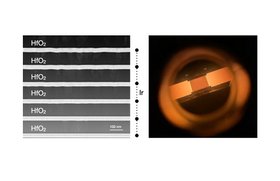When heat becomes electricity at 1000 °C
Thermophotovoltaics: Researchers develop new resistant emitter based on iridium
11.09.2023

Together with the Technical University of Hamburg and Aalborg University, researchers from the Helmholtz-Zentrum Hereon have developed a new selective emitter based on iridium for thermophotovoltaics. Iridium was thus used for the first time as a material for an emitter, and in the experiments, it showed thermal endurance at high temperatures around 1000 °C. Their study results were recently published in the journal Advanced Materials and open new perspectives for producing electricity from heat.
The conversion of heat radiation into electricity is the principle of thermophotovoltaics. To make the heat efficiently usable in the form of radiant energy, so-called selective emitters are beneficial. They sit between the heat source and the photovoltaic cell and emit only a certain part of the radiation while suppressing the other. The challenge here is that the conversion of heat into electricity takes place at high temperatures around 1000 °C - the emitter must therefore be able to withstand these temperatures without losing its selectivity. In cooperation with the Technical University of Hamburg (TUHH) and Aalborg University, researchers at the Helmholtz-Zentrum Hereon have now succeeded in producing a new emitter based on the resistant metal iridium that can withstand these conditions without losing its effectiveness.
"With iridium, we address both aspects at the same time: selectivity and thermal stability," says Alexander Petrov, who works on optical properties of materials at TUHH. "Selective emitters based on iridium are very good at suppressing unwanted radiation and do not react with oxygen. Iridium is a precious metal like gold, but suitable for high-temperature applications."
"By avoiding the adverse effects of oxidation, we have unlocked the potential for more efficient and sustainable systems." reports Gnanavel Vaidhyanathan Krishnamurthy, lead author of the study and a scientist at the Helmholtz-Zentrum Hereon. "This innovation opens the doors to new possibilities in waste heat recovery, solar thermal power generation and beyond."
The emitter's function
In thermophotovoltaics, as in photovoltaics, radiant energy is converted into electricity by a photovoltaic cell. Thermophotovoltaics utilizes heat radiation from a source which can be heated up by the sun or, for example, is part of steel production. The emitter is located between the heat source and the photovoltaic cell. It consists of several very thin metallic and oxidic layers one after other, which should remain unchanged at high temperatures to enable heat to be converted into electricity. For this purpose, it ideally selectively emits only short-wavelength photons and suppresses long-wavelength ones. This is important because the photovoltaic cell is not able to convert the long-wavelength radiation into electricity. At high temperatures, however, most of the metals oxidise and fail to meet the required function. The researchers were able to show that the newly developed selective emitter made of iridium and hafnium oxide retains its function completely over 100 hours at 1000 °C. The metal withstands the demanding challenges without any losses, which were demonstrated using in-situ X-ray diffraction experiments by the researchers. The successful development of selective emitters based on iridium is an important step in the progress of thermophotovoltaics.
In the transition to renewable energy, securing a constant power supply is of great importance. Thermophotovoltaics could not only generate electricity from industrial waste heat, but also make an important contribution to the conversion of the energy supply to renewable energies. Here, the energy generated by photovoltaics and wind turbines, which naturally fluctuates over time, is temporarily stored in heat reservoirs. When the sun is not shining or the wind is not blowing, the stored heat is extracted from the reservoir and converted into electrical energy by means of thermophotovoltaics, which is then continuously available and, in this way, stabilises the energy grids.
The research work is part of the Collaborative Research Centre SFB 986 of the TUHH and the Helmholtz-Zentrum Hereon, which deals with tailor-made multiscale material systems.
Contacts for press inquiries
Martina Grünwald I Helmholtz-Zentrum Hereon I Press officer
T: +49 (0)4152 87-1784 I presse@hereon.de I www.hereon.de
Kaja Weber I TU Hamburg I Press officer
T: +49 (0)40 42878-3458 I kaja.weber@tuhh.de
Text: Martina Grünwald/Hereon
See also: https://onlinelibrary.wiley.com/doi/10.1002/adma.202305922
TUHH - Public Relations Office







